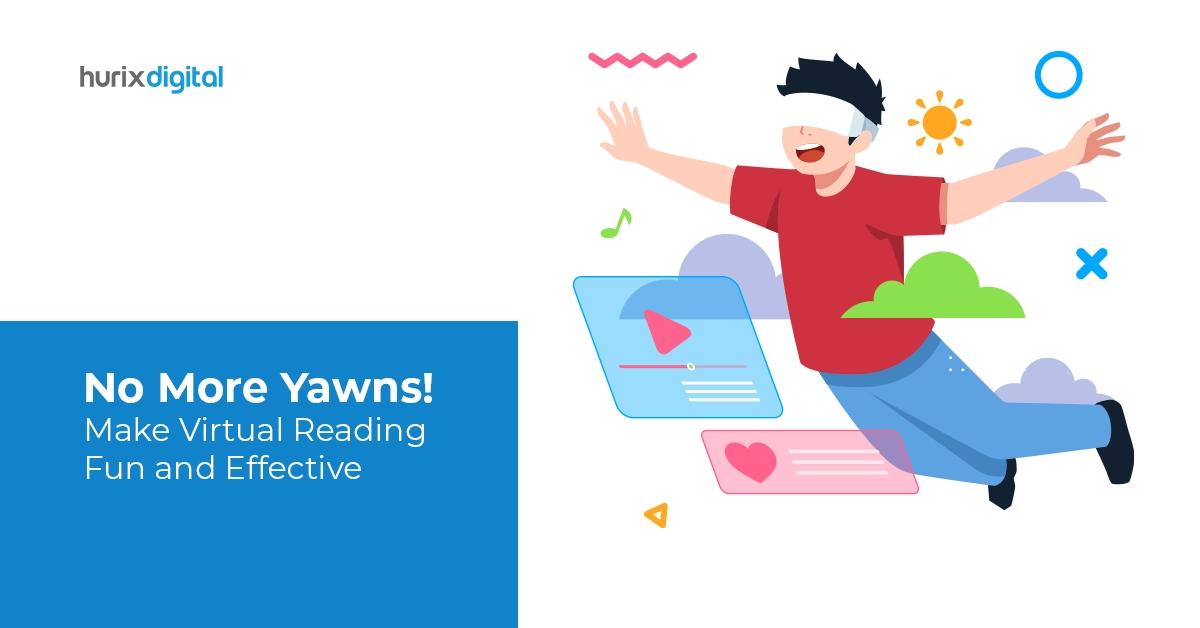
No More Yawns! Make Virtual Reading Fun and Effective
Summary
Discover ways to make virtual reading engaging and effective. This article offers strategies to enhance the virtual reading experience and keep learners interested.
Content creators and publishers generally strive for perfection and immersive reading experiences when creating digital content. Whether your audience is an academic learner, an avid reader, or a busy business leader, it becomes critical to create content that can build virtual reading engagement.
With the increasing popularity of digital content, owing to affordability, accessibility, and portability, the eReader market is projected to increase by USD 7.01 billion at a CAGR of 6.46% between 2023 and 2028. Creators must use interactive learning tools for an engaging online reading experience that will keep readers and learners captivated from beginning to end.
Let us learn more about this in this guide on virtual reading engagement!
Table of Contents:
- What is Reading Engagement?
- Identify Reading Challenges and Introduce a Sense of Adventure in Digital Reading
- How to Develop Virtual Reading Engagement?
- Step-by-Step Guide to Enhance Virtual Reading Engagement
- Conclusion
What is Reading Engagement?
Adding gamified reading experiences and animated storytelling along with text enhances immersion and leads to an engaging online reading environment. Reading proficiency can be gauged by reading engagement.
Reading engagement is a process when readers are motivated to employ strategic reading techniques such as summarization and comprehension monitoring. They can further utilize prior knowledge to comprehend texts, expand their knowledge, and interact socially by discussing texts’ perspectives or sharing reading experiences.
Virtual reading engagement is critical for eLearning opportunities. This $399.3 billion-dollar industry is expected to reach $1 trillion in valuation by 2032. eLearning can be effective mainly with augmented and interactive eBooks, digital storytelling, and interactive learning tools
Identify Reading Challenges and Introduce a Sense of Adventure in Digital Reading
It is important to introduce immersive reading experiences and fun incentives to encourage increased reading. Recent research indicates a significant shift in the landscape of digital reading. Well-crafted digital content can be comprehended effectively, with the added advantage of offering enhanced features and accessibility.
Today, there are rapid advancements in learning and reading technology. Today, readers cite very high levels of confidence in their reading performance when utilizing multimedia reading platforms.
Thus, it becomes even more critical to elevate this confidence and introduce digital readers to the convenience, affordability, and enriched experience offered by digital content.
Also Read: What are the Biggest Challenges of Online Education Today?
How to Develop Virtual Reading Engagement?
Reading is a journey of knowledge expansion, learning, skill development, entertainment, and discovery.
Content creators and publishers must ensure that they instill enthusiasm and adventure in the reading journey to infuse engagement and fun. Virtual reading engagement leads to improved comprehension and enhanced confidence.
Incorporate the following reader engagement strategies for immersive reading experiences:
1. Familiarize Readers with Advanced Features and Functionalities
The first step is to acquaint students with the digital content being utilized. Readers should be able to utilize features such as highlighting passages, taking notes, and searching through important headings.
The content should have an effective orientation and include personalized materials to enrich reading experiences. It is equally important to introduce effective multimedia reading platforms with an intuitive user interface, interactive elements, gamification, and appropriate support for readers.
2. Establish Clear Reading Objectives
Using engaging digital content, you can enhance reader retention by motivating students to approach their reading time with intentionality. General practices that can be included are note-taking capabilities, search features, hyperlink information, and aligning reading material with audience interests.
Delve into subjects that intrigue them, and immerse yourself in topics that captivate their curiosity. This will enhance reader engagement and motivate them to delve deeper into the narrative.
3. Introduce a Collaborative Reading Environment
Readers are thoroughly encouraged when social interaction is involved. Form virtual events and communities or allow readers to visit social media platforms for a structured discussion of content.
Readers should be permitted to share digital notes among peers. This will encourage them to engage more actively, especially with eLearning materials, and eventually attain high course grades.
4. Create Interactive eBooks
Effective digital textbooks are purposefully designed to optimize the digital reading experience. Well-designed digital content should be compatible across various devices and be aligned with evolving student learning preferences. Such content offers several features:
- Enhanced interactivity through media formats like video and audio versions
- Provision of automated, personalized feedback on practice and assessments
- Increased flexibility through customizable features such as highlighting tools, note-taking, typography, etc.
- Improved accessibility and affordability, with access to open educational resources for diverse student populations
5. Diversify Your Reading Genres
Add some zest to reading, and diversify your reading repertoire. Explore different genres and embrace the opportunity to step outside your comfort zone.
Explore new literary horizons and expand your perspectives. Diversifying reading experiences adds excitement, depth, and richness to your virtual reading experience.
6. Simplify Lesson Structure
For a more engaged virtual reading experience, opt for a fast-paced delivery and break down information into easily digestible segments. Avoid lengthy explanations and text-heavy slides, instead go for concise content delivery.
Vary the pace of lessons and introduce a mix of activities that can help you maintain student engagement. Moreover, efforts should be made to personalize student interactions, monitor their performance, and provide regular feedback on their progress.
Step-by-Step Guide to Enhance Virtual Reading Engagement
Follow this step-by-step guide to craft an interactive and personalized reading journey:
Step 1 – Understanding Preferences
Before you start with content creation, identify the genres or topics that genuinely interest your audience, and reflect on hobbies, conversation topics, learning experiences, standards, or favorite forms of entertainment.
Then, experiment with different pacing to find what feels most comfortable for you. Finally, create a conducive reading environment that complements their preferences. Challenge them by introducing diverse genres to broaden their literary horizons and cultivate a versatile reading style.
You can offer a fulfilling virtual reading experience just by aligning your reading material with audience interests and personalizing the reading experience to their preferences.
Step 2 – Choose the Best Multimedia Reading Platforms
You must choose the best platform that is rich in interactive learning tools, digital storytelling, and reader engagement strategies. It should cater to gamified reading experiences and enhance virtual reading engagement.
Consider the following factors before selecting the best platform:
- Content Variety – Look for platforms that offer a diverse range of multimedia content, interactive eBooks, and educational materials.
- User-Friendly Interface: Opt for platforms with intuitive interfaces that make it effortless for readers to access advanced features.
- Multimedia Integration: Choose platforms that seamlessly integrate multimedia elements into the reading experience. Such elements include quizzes, hyperlinks, infographics, charts, videos, GIFs, animations, 3D models, charts, audiobooks, etc.
- Customization Options: Look for platforms that offer customization options, such as font sizes, background colors, reading modes, and bookmarking capabilities.
- Accessibility Features: Ensure that the platform prioritizes accessibility by offering features such as text-to-speech functionality and screen reader compatibility.
- Cross-Platform Compatibility: Choose platforms that are compatible with a variety of devices and operating systems.
- Community Engagement: Consider platforms that encourage a sense of community and interaction among readers through events, communities, and social sharing options.
- Quality Content Curation: Look for platforms that curate high-quality content so that readers have access to well-written, engaging, and informative materials.
- Data Analytics: This is to identify reading goals and celebrate their achievements along the way. This helps organizations understand what motivates and engages readers. This further encourages content creators to delve into new avenues and set achievable reading goals to transform reading into an enjoyable habit.
Step 3 – Continuous Discovery and Experimentation
Continuously explore new authors, genres, and formats, and embrace the opportunity to step outside your comfort zone. Additionally, apply technology to amplify the reading experience.
Step 4 – Setting and Monitoring Goals
Establish clear objectives for each lesson and provide students with a roadmap of the reading and learning process. Offer rewards and incentives to encourage active participation and effort.
Check in regularly with students to set both short-term and long-term goals and celebrate their progress and achievements. This way, you can keep readers motivated and engaged in their virtual reading engagement journey.
Also Read: ChatGPT: Pros and Cons of Using ChatGPT in Higher Education
Conclusion
Immersive reading experiences lead to creativity and adaptability. This holds the attention of readers and learners, enhances their retention power, makes them come back for more, and helps them overcome unique challenges.
Virtual reading engagement may initially appear daunting; however, with consistent effort and innovation, you can enhance the reader experience significantly. It is time to say goodbye to the monotony of reading uninteresting content. Inspire learning and interactive reading and encourage maximum reader participation.
At Hurix Digital, the expert team of professionals will help you with the most effective reader engagement strategies that can offer immersive reading experiences to your readers.
Contact us now to learn more about virtual reading engagement!

Senior Vice President
A Business Development professional with >20 years of experience with strong capability to sell new solutions and develop new markets from scratch. New Market Entry Specialist with experience of working in two of the largest emerging markets – China & India. Also covered other key markets in APAC, US, EU & ME. Exceptional experience of conceptualizing, ideating and selling new learning technologies like VR AR, etc. across multiple industry verticals.




